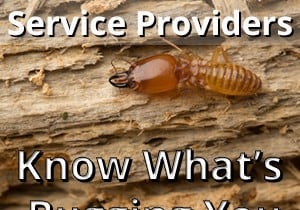Termites are said to cause billions of dollars in structural damage each year. According to data from the Environmental Protection Agency (EPA), property owners spend more than $2 billion to treat the wood-feeding pests. Except for Alaska, termites are found in every state, from Washington in the Pacific Northwest to the tip of southern Florida. So, do you know if your home is at risk?
What Are Termites?
Two species of termites are known to infest American homes. The subterranean species lives in colonies and can tunnel for hundreds of feet underground to reach a food source. The other common species, the drywood termite, is commonly found in the flooring, walls and even the furniture inside a home.
Both species of these pests are active year-round; however, they are known as the silent destroyer and can often go undetected for long periods of time. According to Realtor.com, they are more likely to be noticed during the spring months as temperatures warm.
Spotting Termite Damage
Because these pests mostly live hidden in the walls of a structure or underground, they can be difficult to spot with the untrained eye. However, there are a handful of telltale signs of an infestation. If your home has mud tubes on its exterior walls or foundation, an infestation is likely.
Additionally, termite droppings, or “frass,” which resemble tiny wood-pellets, and shedded wings near the entry points of a home both indicate an infestation. Again, these signs may be difficult to spot without the proper education and training of a professional. If you suspect a termite infestation, contact a pest control professional immediately.
Choosing an exterminator can be a difficult task. Many homeowners have concerns about the preventative methods and chemicals used during the treatment process and whether or not they may cause harm to pets or children. Others are concerned about a pest professional’s certification and training.
When selecting an exterminator, always choose a licensed professional. A certification will ensure that they have the proper training to successfully do the job, and many states require a certification. Feel free to ask the pest control company for a copy of licenses or certifications from a pest regulation company.
Preventing Devastating Termite Damage
Termites are drawn to moist environments. One way to prevent an infestation of these tiny pests is to eliminate sources of moisture around your home. Fix leaky pipes, dripping air conditioner units and other leak-prone fixtures. Drainage sites, such as gutters and downspouts, should be maintained and kept clear of debris. Other preventative measures include caulking the cracks in the home’s foundation to eliminate access points as well as sealing access points around utility lines or plumbing.
Areas around your home deserve just as much attention in your termite prevention plan. Plants and mulch in the yard should be well maintained, and yard debris like old stumps should be discarded, as termites feed on woody materials.








